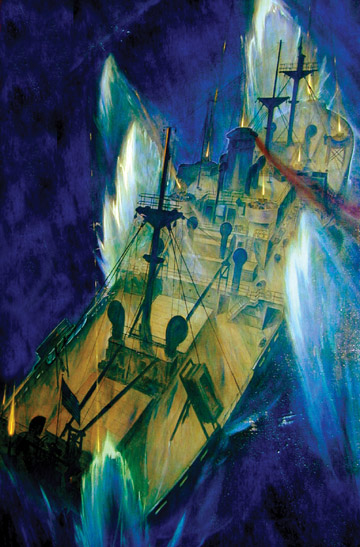Liberty
Ship Awash
 The
above is an adaptation by Bay Crossings’ Art Director Francisco
Arreola of one part of a dramatic triptych hanging in the grand
hiring hall of the Sailors’ Union headquarters at First and Harrison
Streets in San Francisco. It depicts a heroic battle between the
Liberty ship SS Stephen Hopkins and German raiders in the South
Atlantic on September 27, 1942. The following account of the action
excerpted from U.S. Merchant Vessel War Casualties of World
War II, by Robert W. Browning Jr. (Naval Institute Press, reprinted
with permission):
The
above is an adaptation by Bay Crossings’ Art Director Francisco
Arreola of one part of a dramatic triptych hanging in the grand
hiring hall of the Sailors’ Union headquarters at First and Harrison
Streets in San Francisco. It depicts a heroic battle between the
Liberty ship SS Stephen Hopkins and German raiders in the South
Atlantic on September 27, 1942. The following account of the action
excerpted from U.S. Merchant Vessel War Casualties of World
War II, by Robert W. Browning Jr. (Naval Institute Press, reprinted
with permission):
On 18 September, the Stephen
Hopkins (Paul Buck, Captain) sailed from Cape Town, South Africa,
to Paramaribo, Dutch Guiana. Several days out of Cape Town, the
radio operator received a message warning of German raiders. On the
morning of the 27th a lookout spotted two ships in the haze flying
signal flags. They were in reality the 5,000-ton raider Stier
and the 7,800-ton Tannenfels. Both immediately began firing
on the Liberty ship, and what ensued was one of the most remarkable
surface engagements of the war. Captain Buck immediately turned the Hopkins
stern to the raiders. The armed guards manned the four-inch stern
gun to defend the ship. The gun crew fired as rapidly as possible on
the smaller raider. Fire from the Stier killed the gun crew
one by one and volunteers replaced those who had fallen. At the same
time, the Tannenfels remained at a distance, raking the Hopkins
with machine gun fire that was returned by the Hopkins. The Stier
had a fire control system that enabled her to fire salvos and hit
the Liberty ship repeatedly. One shell hit one of the main boilers,
reducing the speed of the Stephen Hopkins to one knot. Shells
struck the Hopkins near the waterline, and incendiary shells
eventually set fire to the main deckhouse as the ship slowly sank.
The Stier, however, had paid for attacking the Stephen
Hopkins. The Hopkins crew had repeatedly struck the
smaller raider, now in flames and in a sinking condition. After
about twenty minutes of fierce firing, the master sounded the ship’s
whistle to abandon ship. In one last act of defiance, Cadet
Midshipman Edwin O’Hara fired the last five remaining shells from
the four-inch gun, and all struck the Stier. A salvo aimed at
the gun killed O’Hara after he had fired the last round. The
able-bodied men helped place the wounded in the only undamaged
lifeboat. This boat searched for two hours picking up survivors. The
ship’s complement originally consisted of eight officers,
thirty-three men, and fifteen armed guards but only nineteen men
cleared the ship. Only fifteen of these men survived – gunners,
one officer and nine men. After a thirty-one day trip they made
landfall at a small fishing village on the coast of Brazil.